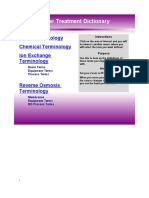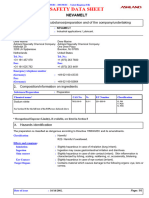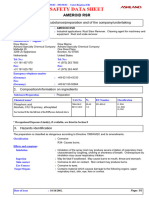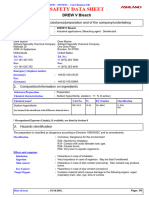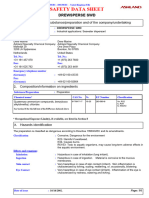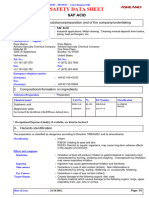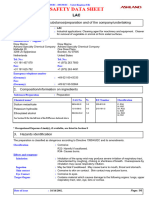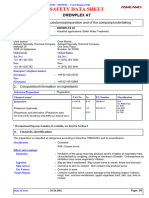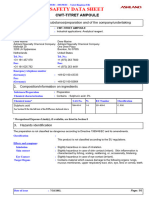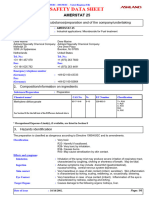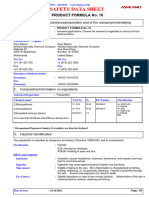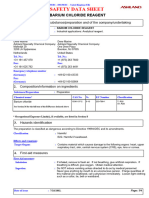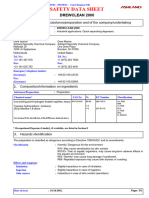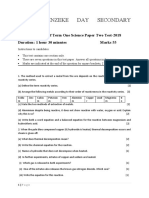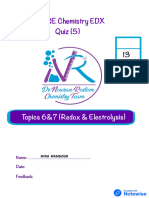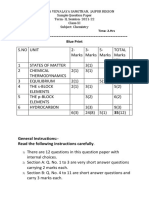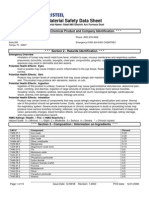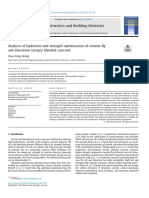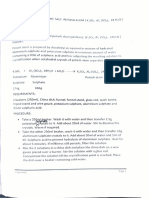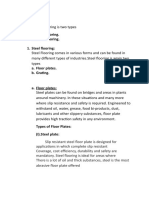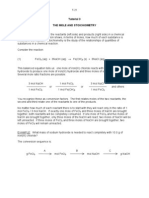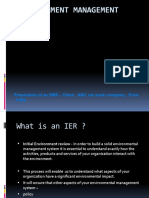1725 Hnu5c5kub
1725 Hnu5c5kub
Uploaded by
Nandar Min HtetCopyright:
Available Formats
1725 Hnu5c5kub
1725 Hnu5c5kub
Uploaded by
Nandar Min HtetOriginal Title
Copyright
Available Formats
Share this document
Did you find this document useful?
Is this content inappropriate?
Copyright:
Available Formats
1725 Hnu5c5kub
1725 Hnu5c5kub
Uploaded by
Nandar Min HtetCopyright:
Available Formats
Conforms to 91/155/EEC - 2001/58/EC - United Kingdom (UK)
SAFETY DATA SHEET
DREW ABD
1. Identification of the substance/preparation and of the company/undertaking
Product name : DREW ABD
Material Uses : Industrial applications: Cleaner for removal of vegetable or animal oil from
soiled surfaces.
Manufacturer / Supplier :
Drew Marine Drew Marine
Ashland Specialty Chemical Company Ashland Specialty Chemical Company
Malledijk 20 One Drew Plaza
3208 LA Spijkenisse Boonton, NJ 07005
Netherlands United States
Tel. No.: Tel. No.:
+31 181 457 070 +1 (973) 263 7600
Fax: Fax:
+31 181 625 792 +1 (973) 263 4491
Emergency telephone number
(Germany) : +49 621 60-43333
Fax:
(Germany) : +49 621 60-92664
2. Composition/information on ingredients
Substance/Preparation : Preparation
Chemical name* CAS No. % EC Number Classification
Sodium hydroxide 1310-73-2 20-30 215-185-5 C; R35
Glucoside 68515-73-1 0.5-1 Xi; R41
See Section 16 for the full text of the R Phrases declared above
* Occupational Exposure Limit(s), if available, are listed in Section 8
3. Hazards identification
The preparation is classified as dangerous according to Directive 1999/45/EC and its amendments.
Classification : Corrosive
R35- Causes severe burns.
Effects and symptoms
Inhalation : Inhalation of the spray mist may produce severe irritation of respiratory tract,
characterized by coughing, choking or shortness of breath. Overexposure by
inhalation may cause respiratory irritation.
Ingestion : May be fatal if swallowed. May cause burns to mouth, throat and stomach.
Skin contact : Corrosive to skin on contact. Skin contact may produce burns.
Eye Contact : Corrosive to eyes.
Target Organs : Contains material which causes damage to the following organs: lungs, upper
respiratory tract, skin, eye, lens or cornea.
Date of issue : 10/16/2002. Page: 1/5
DREW ABD
4. First-aid measures
First-Aid measures
Inhalation : If inhaled, remove to fresh air. If not breathing, give artificial respiration. If
breathing is difficult, give oxygen. Obtain medical attention immediately.
Ingestion : Do NOT induce vomiting unless directed to do so by medical personnel.
Never give anything by mouth to an unconscious person. Loosen tight clothing
such as a collar, tie, belt or waistband. Get medical attention if symptoms
appear.
Skin contact : In case of contact, immediately flush skin copiously with water for at least 15
minutes while removing contaminated clothing and shoes. Cold water may be
used. Wash clothing before reuse. Clean shoes thoroughly before reuse.
Obtain medical attention immediately.
Eye Contact : Check for and remove any contact lenses. In case of contact, immediately
flush eyes with a copious amount of water for at least 15 minutes. Cold water
may be used. Obtain medical attention immediately.
5. Fire-fighting measures
Extinguishing Media
Suitable : Not applicable.
Hazardous thermal (de)composition : These products are carbon oxides (CO, CO2) and water. Some metallic
products oxides.
Protection of fire-fighters : Fire fighters should wear self-contained positive pressure breathing apparatus
(SCBA) and full turnout gear.
6. Accidental release measures
Personal Precautions : Splash goggles. Full suit. Boots. Gloves. Suggested protective clothing
might not be sufficient; consult a specialist BEFORE handling this product.
Environmental precautions and : Stop leak if without risk. Absorb with dry earth, sand or other noncombustible
cleanup methods material. Use water spray curtain to divert vapour drift. Prevent entry into
sewers, basements or confined areas; dike if needed. Call for assistance on
disposal. Neutralize the residue with a dilute solution of acetic acid.
Note: See section 8 for personal protective equipment and section 13 for waste disposal.
7. Handling and storage
Handling : Keep container dry. Keep away from heat. Keep away from sources of
ignition. Empty containers pose a fire risk, evaporate the residue under a
fume hood. Do not ingest. Do not breathe gas/fumes/vapour/spray. Wear
suitable protective clothing. If ingested, seek medical advice immediately and
show the container or the label. Keep away from incompatibles such as
acids.
Storage : Keep container tightly closed. Keep container in a cool, well-ventilated area.
Packaging materials
Recommended use : Use original container.
8. Exposure controls/personal protection
Engineering measures : Provide exhaust ventilation or other engineering controls to keep the airborne
concentrations of vapours below their respective occupational exposure limits.
Hygiene measures : Wash hands after handling compounds and before eating, smoking, using
lavatory, and at the end of day.
Occupational Exposure Limits
Date of issue : 10/16/2002. Page: 2/5
DREW ABD
Ingredient Name Occupational Exposure Limits
Sodium hydroxide EH40-OES (United Kingdom (UK), 2001). Notes: OES
STEL: 2 mg/m3
Respiratory system : Wear appropriate respirator when ventilation is inadequate.
Skin and body : Full suit.
Hands : Impervious gloves.
Eyes : Face shield.
9. Physical and chemical properties
Physical state : Liquid.
Colour : Light brown.
Odour : Not available.
Boiling point : 105°C (221°F)
Melting point : -22°C (-8°F)
Density : 1.32 g/cm3
Vapour pressure : The highest known value is 2.33 kPa (17.5 mmHg) (at 20°C) (Water).
Evaporation Rate : 0.36 (Water) compared to n-Butyl acetate
Solubility : Easily soluble in cold water.
pH : 14 [Basic.]
Flash point : Not applicable.
10. Stability and reactivity
Stability : The product is stable.
Materials to avoid : Highly reactive with acids.
Slightly reactive to reactive with organic materials, metals.
Incompatible with copper alloys. Incompatible with magnesium, zinc, sodium,
potassium and aluminium.
Hazardous decomposition products : These products are carbon oxides (CO, CO2) and water. Some metallic
oxides.
Remarks : Flammable hydrogen gas may be produced on prolonged contact with metals
such as aluminium, zinc, etc.
11. Toxicological information
Acute toxicity
Ingredient Name Test Result Route Species
Sodium hydroxide LDLo 500 mg/kg Oral Rabbit
Glucoside LD50 >5000 Oral Rat
mg/kg
LD50 >5000 Dermal Rabbit
mg/kg
Chronic toxicity : Repeated or prolonged contact with spray mist may produce chronic eye
irritation and severe skin irritation. Repeated or prolonged exposure to spray
mist may produce respiratory tract irritation, leading to frequent attacks of
bronchial infection.
Skin irritation : Extremely hazardous in case of skin contact (corrosive).
Eye irritation : Extremely hazardous in case of eye contact (corrosive).
Date of issue : 10/16/2002. Page: 3/5
DREW ABD
Carcinogenic effects : Not available.
Mutagenic Effects : Not available.
Reproduction toxicity : Not available.
12. Ecological information
Persistence/degradability : Not available.
13. Disposal considerations
Methods of disposal ; Waste of : Waste must be disposed of in accordance with federal, state and local
residues ; Contaminated packaging environmental control regulations.
European Waste Catalogue (EWC) : 160502
Hazardous Waste : The classification of the product may meet the criteria for a hazardous waste.
14. Transport information
International transport regulations
Land - Road/Railway
UN number : 1824
Proper shipping name : SODIUM HYDROXIDE SOLUTION
ADR/RID Class : 8
Packing group : II
ADR/RID label :
Other information : Hazard identification number
80
Sea
UN number : 1824
Proper shipping name : SODIUM HYDROXIDE SOLUTION
IMDG Class : 8
Packing group : II
IMDG label :
Other information : Emergency Schedules (EmS)
8-06
15. Regulatory information
EU Regulations
Hazard symbol(s) :
Corrosive
Date of issue : 10/16/2002. Page: 4/5
DREW ABD
Risk Phrases : R35- Causes severe burns.
Safety Phrases : S26- In case of contact with eyes, rinse immediately with plenty of water and
seek medical advice.
S36/37/39- Wear suitable protective clothing, gloves and eye/face protection.
S45- In case of accident or if you feel unwell, seek medical advice
immediately (show the label where possible).
Contains : Sodium hydroxide 215-185-5
Product Use : Classification and labelling have been performed according to EU directives
67/548/EEC, 88/379/EEC, including amendments and the intended use.
- Industrial applications.
16. Other information
Full text of R-Phrases with no. : R35- Causes severe burns.
appearing in Section 2 - United R41- Risk of serious damage to eyes.
Kingdom (UK)
Text of classifications appearing in : C - Corrosive
Section 2 - United Kingdom (UK) Xi - Irritant
HISTORY
Date of printing : 10/17/2002.
Date of issue : 10/16/2002.
Version : 3
DREW™ ABD is a trademark of Ashland Inc.
Notice to Reader
To the best of our knowledge, the information contained herein is accurate. However, neither the above named supplier nor
any of its subsidiaries assumes any liability whatsoever for the accuracy or completeness of the information contained
herein.
Final determination of suitability of any material is the sole responsibility of the user. All materials may present unknown
hazards and should be used with caution. Although certain hazards are described herein, we cannot guarantee that these
are the only hazards that exist.
Date of issue Version
10/16/2002. 3 Page: 5/5
You might also like
- Project Report On Aluminium Slugs ManufacturingDocument5 pagesProject Report On Aluminium Slugs ManufacturingEIRI Board of Consultants and PublishersNo ratings yet
- Aluminum SmelterDocument10 pagesAluminum SmeltersadiaNo ratings yet
- Water Treatment DictionaryDocument48 pagesWater Treatment DictionarydavideristixNo ratings yet
- CSEC Chemistry January 2018 P1 PDFDocument11 pagesCSEC Chemistry January 2018 P1 PDFShalini K86% (7)
- Als 268 03 Issue 03Document27 pagesAls 268 03 Issue 03rollickingdeol57% (7)
- 1213 28v5c5kubDocument5 pages1213 28v5c5kubNandar Min HtetNo ratings yet
- 1272 0s3cc5kubDocument5 pages1272 0s3cc5kubNandar Min HtetNo ratings yet
- 0026 Bgvac5kubDocument5 pages0026 Bgvac5kubNandar Min HtetNo ratings yet
- 9511 Lktjc5kubDocument5 pages9511 Lktjc5kubNandar Min HtetNo ratings yet
- 4907 Avkbc5kubDocument5 pages4907 Avkbc5kubNandar Min HtetNo ratings yet
- 5247 Qahtc5kubDocument5 pages5247 Qahtc5kubNandar Min HtetNo ratings yet
- 1265 Tvtnc5kubDocument5 pages1265 Tvtnc5kubNandar Min HtetNo ratings yet
- 0007 Ok15c5kubDocument5 pages0007 Ok15c5kubNandar Min HtetNo ratings yet
- 1274 N48uc5kubDocument6 pages1274 N48uc5kubNandar Min HtetNo ratings yet
- 0041 Q6boc5kubDocument5 pages0041 Q6boc5kubNandar Min HtetNo ratings yet
- 0082 Hvipc5kubDocument5 pages0082 Hvipc5kubNandar Min HtetNo ratings yet
- 9534 G499c5kubDocument5 pages9534 G499c5kubNandar Min HtetNo ratings yet
- 0091 Lpfvc5kubDocument5 pages0091 Lpfvc5kubNandar Min HtetNo ratings yet
- 0011 1550c5kubDocument5 pages0011 1550c5kubNandar Min HtetNo ratings yet
- 1717 43eoc5kubDocument6 pages1717 43eoc5kubNandar Min HtetNo ratings yet
- 1726 Q99kc5kubDocument5 pages1726 Q99kc5kubNandar Min HtetNo ratings yet
- 5148 L85ac5kubDocument5 pages5148 L85ac5kubNandar Min HtetNo ratings yet
- Vtrdc5kubDocument6 pagesVtrdc5kubNandar Min HtetNo ratings yet
- 0089 Ei6uc5kubDocument5 pages0089 Ei6uc5kubNandar Min HtetNo ratings yet
- 0062 J5tfc5kubDocument5 pages0062 J5tfc5kubNandar Min HtetNo ratings yet
- 6623 Cp4qc5kubDocument5 pages6623 Cp4qc5kubNandar Min HtetNo ratings yet
- 1731 78mtc5kubDocument5 pages1731 78mtc5kubNandar Min HtetNo ratings yet
- 1706 Hdtpc5kubDocument5 pages1706 Hdtpc5kubNandar Min HtetNo ratings yet
- 1266 9uh7c5kubDocument6 pages1266 9uh7c5kubNandar Min HtetNo ratings yet
- 0057 M4t2c5kubDocument6 pages0057 M4t2c5kubNandar Min HtetNo ratings yet
- Peb6c5kubDocument6 pagesPeb6c5kubNandar Min HtetNo ratings yet
- 1270 Lh7vc5kubDocument6 pages1270 Lh7vc5kubNandar Min HtetNo ratings yet
- 0097 3s68c5kubDocument5 pages0097 3s68c5kubNandar Min HtetNo ratings yet
- 1743 Tdjsc5kubDocument5 pages1743 Tdjsc5kubNandar Min HtetNo ratings yet
- 0031 Ck14c5kubDocument5 pages0031 Ck14c5kubNandar Min HtetNo ratings yet
- 1732 0btnc5kubDocument4 pages1732 0btnc5kubNandar Min HtetNo ratings yet
- 6598 Gvecc5kubDocument6 pages6598 Gvecc5kubNandar Min HtetNo ratings yet
- 1277 Upu8c5kubDocument4 pages1277 Upu8c5kubNandar Min HtetNo ratings yet
- 4608 Vpmmc5kubDocument5 pages4608 Vpmmc5kubNandar Min HtetNo ratings yet
- 9517 K87fc5kubDocument5 pages9517 K87fc5kubNandar Min HtetNo ratings yet
- Hhe4c5kubDocument10 pagesHhe4c5kubNandar Min HtetNo ratings yet
- 1259 P8e7c5kubDocument5 pages1259 P8e7c5kubNandar Min HtetNo ratings yet
- 5482 3a11c5kubDocument4 pages5482 3a11c5kubNandar Min HtetNo ratings yet
- 1280 Bktpc5kubDocument5 pages1280 Bktpc5kubNandar Min HtetNo ratings yet
- 0005 Ll64c5kubDocument6 pages0005 Ll64c5kubNandar Min HtetNo ratings yet
- 4757 54a6c5kubDocument6 pages4757 54a6c5kubNandar Min HtetNo ratings yet
- 5 C 5 KubDocument6 pages5 C 5 KubNandar Min HtetNo ratings yet
- 5483 Ahi7c5kubDocument5 pages5483 Ahi7c5kubNandar Min HtetNo ratings yet
- 0045 Lfu5c5kubDocument5 pages0045 Lfu5c5kubNandar Min HtetNo ratings yet
- 0076 Fi41c5kubDocument5 pages0076 Fi41c5kubNandar Min HtetNo ratings yet
- 1279 Srvmc5kubDocument6 pages1279 Srvmc5kubNandar Min HtetNo ratings yet
- Gfebc5kubDocument4 pagesGfebc5kubNandar Min HtetNo ratings yet
- 4139 Jo0mc5kubDocument6 pages4139 Jo0mc5kubNandar Min HtetNo ratings yet
- D0tqc5kubDocument5 pagesD0tqc5kubNandar Min HtetNo ratings yet
- 0060 Me5pc5kubDocument5 pages0060 Me5pc5kubNandar Min HtetNo ratings yet
- 0065 Behqc5kubDocument4 pages0065 Behqc5kubNandar Min HtetNo ratings yet
- 1273 20bgc5kubDocument5 pages1273 20bgc5kubNandar Min HtetNo ratings yet
- 1214 Lfp0c5kubDocument4 pages1214 Lfp0c5kubNandar Min HtetNo ratings yet
- 1702 Tq0ac5kubDocument4 pages1702 Tq0ac5kubNandar Min HtetNo ratings yet
- 0544 E1ifc5kubDocument5 pages0544 E1ifc5kubNandar Min HtetNo ratings yet
- 1295 1047c5kubDocument6 pages1295 1047c5kubNandar Min HtetNo ratings yet
- 0098 T8f8c5kubDocument5 pages0098 T8f8c5kubNandar Min HtetNo ratings yet
- 1269 5vp7c5kubDocument6 pages1269 5vp7c5kubNandar Min HtetNo ratings yet
- 5481 D9u7c5kubDocument5 pages5481 D9u7c5kubNandar Min HtetNo ratings yet
- 6598 Gvecc5kubDocument6 pages6598 Gvecc5kubNandar Min HtetNo ratings yet
- 7266 Fq1hc5kubDocument5 pages7266 Fq1hc5kubNandar Min HtetNo ratings yet
- 2bhlc5kubDocument4 pages2bhlc5kubNandar Min HtetNo ratings yet
- 5482 3a11c5kubDocument4 pages5482 3a11c5kubNandar Min HtetNo ratings yet
- 4139 Jo0mc5kubDocument6 pages4139 Jo0mc5kubNandar Min HtetNo ratings yet
- 5481 D9u7c5kubDocument5 pages5481 D9u7c5kubNandar Min HtetNo ratings yet
- 403 Between and Among 260322Document24 pages403 Between and Among 260322Nandar Min HtetNo ratings yet
- 0051 Strcc5kubDocument6 pages0051 Strcc5kubNandar Min HtetNo ratings yet
- 0651 Lb6gc5kubDocument5 pages0651 Lb6gc5kubNandar Min HtetNo ratings yet
- 1743 Tdjsc5kubDocument5 pages1743 Tdjsc5kubNandar Min HtetNo ratings yet
- 9517 K87fc5kubDocument5 pages9517 K87fc5kubNandar Min HtetNo ratings yet
- 1274 N48uc5kubDocument6 pages1274 N48uc5kubNandar Min HtetNo ratings yet
- 0089 Ei6uc5kubDocument5 pages0089 Ei6uc5kubNandar Min HtetNo ratings yet
- 0031 Ck14c5kubDocument5 pages0031 Ck14c5kubNandar Min HtetNo ratings yet
- 0007 Ok15c5kubDocument5 pages0007 Ok15c5kubNandar Min HtetNo ratings yet
- 0091 Lpfvc5kubDocument5 pages0091 Lpfvc5kubNandar Min HtetNo ratings yet
- 0572 Ku0cc5kubDocument5 pages0572 Ku0cc5kubNandar Min HtetNo ratings yet
- 0036 6t5ec5kubDocument7 pages0036 6t5ec5kubNandar Min HtetNo ratings yet
- 0041 Q6boc5kubDocument5 pages0041 Q6boc5kubNandar Min HtetNo ratings yet
- Participle Clauses-260322Document34 pagesParticiple Clauses-260322Nandar Min HtetNo ratings yet
- 0057 M4t2c5kubDocument6 pages0057 M4t2c5kubNandar Min HtetNo ratings yet
- Adjectives Without Nouns-260322Document27 pagesAdjectives Without Nouns-260322Nandar Min HtetNo ratings yet
- 21.1 Topic SUCCESS Lesson Notes-6Document1 page21.1 Topic SUCCESS Lesson Notes-6Nandar Min HtetNo ratings yet
- Experiment and Experience-260322Document30 pagesExperiment and Experience-260322Nandar Min HtetNo ratings yet
- Kenshin Myanmar 3 Cross-Shaped ScarDocument140 pagesKenshin Myanmar 3 Cross-Shaped ScarNandar Min HtetNo ratings yet
- Kenshin Myanmar 2 Legend of KyotoDocument137 pagesKenshin Myanmar 2 Legend of KyotoNandar Min HtetNo ratings yet
- Kenshin Myanmar 1 Wandering SamuraiDocument170 pagesKenshin Myanmar 1 Wandering SamuraiNandar Min HtetNo ratings yet
- PREPARATION OF POTASSIUM ALUMINUM SULFATE, KAl (SO4) 2 - 12H2O (Alum)Document5 pagesPREPARATION OF POTASSIUM ALUMINUM SULFATE, KAl (SO4) 2 - 12H2O (Alum)vinsmoke1No ratings yet
- Industry Statistics: Major Industrial Areas/ Zones in OrissaDocument17 pagesIndustry Statistics: Major Industrial Areas/ Zones in OrissaBhavani PrasadNo ratings yet
- Metals From Ores: 2. Scope of Extractive MetallurgyDocument48 pagesMetals From Ores: 2. Scope of Extractive MetallurgyAdetiyo Burhanudin HakimNo ratings yet
- 6082 Aluminium AlloyDocument3 pages6082 Aluminium AlloyWeiso ChenNo ratings yet
- Year 7 UT 3Document5 pagesYear 7 UT 3Kissiedu YirenkyiNo ratings yet
- 2018 Science Paper 2 Grade 12Document3 pages2018 Science Paper 2 Grade 12Davies MasumbaNo ratings yet
- IGCSE Chemistry Quiz : Cs 6&7 (Redox & Electrolysis)Document6 pagesIGCSE Chemistry Quiz : Cs 6&7 (Redox & Electrolysis)7esab3mkNo ratings yet
- 11th Chemistry Model PaperDocument13 pages11th Chemistry Model Papersasi.curieNo ratings yet
- Steel Mill Electric Arc Furnace Dust MSDS (NA) 12-8-08Document15 pagesSteel Mill Electric Arc Furnace Dust MSDS (NA) 12-8-08Agustine SetiawanNo ratings yet
- Aluminum 6060 T5Document9 pagesAluminum 6060 T5Doreen PohNo ratings yet
- Amptiac: Transparent ArmorDocument24 pagesAmptiac: Transparent ArmorSelim KayaNo ratings yet
- Analysis of Hydration and Strength Optimization of Cement-Fly Ash-Limestone Ternary Blended ConcreteDocument11 pagesAnalysis of Hydration and Strength Optimization of Cement-Fly Ash-Limestone Ternary Blended ConcreteMJundiNo ratings yet
- Class 12 Expt 18 Preparation of Inorganic SaltDocument2 pagesClass 12 Expt 18 Preparation of Inorganic Saltsridemass321No ratings yet
- Gta Analytical Methods 0848Document226 pagesGta Analytical Methods 0848milossmile100% (1)
- "Magnetic Abrasive Finishing Machine": A Project ReportDocument42 pages"Magnetic Abrasive Finishing Machine": A Project Reportvarun dhavanNo ratings yet
- Types of FlooringDocument7 pagesTypes of FlooringDIBYENDU MONDALNo ratings yet
- Tutorial 3Document6 pagesTutorial 3asuhassNo ratings yet
- Aluminium Scrap: AIM: To Prepare Potash Alum FromDocument18 pagesAluminium Scrap: AIM: To Prepare Potash Alum FromJagdishNo ratings yet
- Elaboración de Panel Aislante Acústico y Térmico A Partir de La Reutilización de Botellas Plásticas de Polietileno Tereftalato (Pet)Document12 pagesElaboración de Panel Aislante Acústico y Térmico A Partir de La Reutilización de Botellas Plásticas de Polietileno Tereftalato (Pet)Luis Leonardo LiraNo ratings yet
- Environment Management: Preparation of An EMS - Client: ABC Car Wash Company, Pune, IndiaDocument22 pagesEnvironment Management: Preparation of An EMS - Client: ABC Car Wash Company, Pune, IndiaaggarwalramitNo ratings yet
- AlSICuMg CastingDocument9 pagesAlSICuMg CastingSantosh KumarNo ratings yet
- Al Jaber Industries & Trading Division: Ajecobond - Al Jaber Aluminium Composite Panels L.L.CDocument21 pagesAl Jaber Industries & Trading Division: Ajecobond - Al Jaber Aluminium Composite Panels L.L.CHelen Kate Saccuan100% (1)
- The Geochemistry of Rare Earth Elements (REE) in Acid Mine Drainage From The Sitai Coal Mine, Shanxi Province, North ChinaDocument9 pagesThe Geochemistry of Rare Earth Elements (REE) in Acid Mine Drainage From The Sitai Coal Mine, Shanxi Province, North ChinaAbie BadhurahmanNo ratings yet
- Testing Charges of OSLDocument28 pagesTesting Charges of OSLSebastian RajeshNo ratings yet
- Aluminium Profiles and SkirtingsDocument2 pagesAluminium Profiles and SkirtingsakhanNo ratings yet


